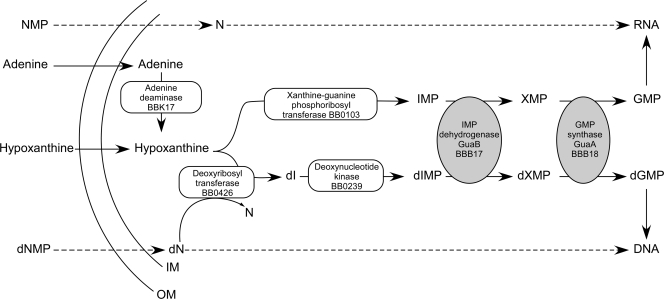FIG. 1.
Pivotal role of the GuaAB proteins in the purine salvage pathway of B. burgdorferi. A novel pathway for purine salvage has recently been elucidated for B. burgdorferi (23). Extracellular adenine and hypoxanthine are salvaged by B. burgdorferi from mammalian and tick host environments (61). Following transport, adenine can be converted to hypoxanthine by adenine deaminase (BBK17) (21). This pathway proposes two possible fates for hypoxanthine, as follows. (i) Hypoxanthine is converted to IMP by a putative xanthine-guanine phosphoribosyl transferase (BB0103), IMP is converted to XMP by IMPDH (GuaB or BBB17), and XMP is converted to GMP by GMP synthase (GuaA or BBB18), resulting in guanine nucleotides for RNA synthesis. (ii) Direct transport of deoxynucleosides appears to provide a source of deoxyribose for interconversion of hypoxanthine to deoxyinosine by a deoxyribosyl transferase (BB0426) (23). dIMP is generated by a putative deoxynucleotide kinase (BB0239). GuaB converts dIMP to dXMP, and GuaA converts dXMP to dGMP, providing guanine deoxynucleotides for DNA synthesis (23). Salvage of free guanine nucleosides and guanine deoxynucleosides, when they are available in the host environment, may allow B. burgdorferi to circumvent the GuaAB requirement for GMP and dGMP biosynthesis. The dashed arrows indicate dephosphorylation of nucleotide monophosphate or deoxynucleotide monophosphate prior to transport by the spirochete and rephosphorylation of nucleoside and deoxynucleoside to nucleotide triphosphate and deoxynucleotide triphosphate, respectively, for RNA and DNA synthesis. NMP, nucleotide monophosphate; N, nucleoside; dN, deoxynucleoside; dNMP, deoxynucleotide monophosphate; OM, outer membrane; IM, inner membrane.

